
Puzzled by all the latest developments and observed features in LRDs? We tried to summarize the key features, our interpretation, alternatives and challenges in this table:
03.10.2025 07:54 — 👍 1 🔁 0 💬 0 📌 0
@jorryt.bsky.social
Extragalactic astrophysicist. Assistant Prof @ IST Austria - PI of ERC StG-2022 AGENTS. PhD Leiden 2018, Zwicky fellow @ ETH Zurich,2018-2023.

Puzzled by all the latest developments and observed features in LRDs? We tried to summarize the key features, our interpretation, alternatives and challenges in this table:
03.10.2025 07:54 — 👍 1 🔁 0 💬 0 📌 0
What does this mean? This very luminous LRD likely resides in a very low mass galaxy. The BH mass is unlikely as high as the virial indicators suggest, because the broadening is not dynamical. What the BH mass is.. a wide range is still possible, and we should find new ways of figuring that out!
03.10.2025 07:54 — 👍 0 🔁 0 💬 1 📌 0
Despite most of the light being dominated by the "LRD" (which we think is an accreting SMBH highly covered by dense gas), there are some indications of host galaxy light, in particular the extremely narrow [OIII] emission and some (similarly) narrow Hgamma emission that pops up
03.10.2025 07:54 — 👍 0 🔁 0 💬 1 📌 0
Using Cloudy modeling, we can connect the various observed features: [FeII], scattering & collisionally dominated Balmer emission and the now well-known Balmer break of LRDs: a warm layer of dense gas (T~7000 K, ne~10^9 cm3) is responsible.
03.10.2025 07:54 — 👍 0 🔁 0 💬 1 📌 0
The most surprising observed feature is a forest of [FeII] emission lines -- these lines are commonly observed in quasars but they tend to be much broader. This is further evidence that the dense gas is not moving as rapidly as the line-widths of the Balmer lines suggest.
03.10.2025 07:54 — 👍 0 🔁 0 💬 1 📌 0Together, this is a radically different explanation than is common, where line-profiles are explained as a composite of narrow emission from low density gas and broad emission from fast moving regions of gas, and the absorber would be a decoupled cloud of gas.
03.10.2025 07:54 — 👍 0 🔁 0 💬 1 📌 0The wings are exponential with an indistinguishable width, suggesting they emerge from electron scattering -- likely in the same layer of dense gas. Another exciting feature are the line-ratios: Ha/Hb~10. This is likely because of collisional effects in this dense gas.
03.10.2025 07:54 — 👍 0 🔁 0 💬 1 📌 0The P Cygni profile emerges because there is a layer of partially excited, very dense gas with a significant population of H atoms in the n=2 state. Resonant scattering in this layer (and complicated decay effects of Hb photons) cause the differences in the cores.
03.10.2025 07:54 — 👍 0 🔁 0 💬 1 📌 0
With our new deep JWST NIRspec IFU Prism+G395H data, we can characterize the Balmer lines in unprecedented detail; We confirm the absorption seen in grism data, show it's also present in other transitions, and we argue the line-profiles are best explained by exponential wings with P Cygni cores.
03.10.2025 07:54 — 👍 0 🔁 0 💬 1 📌 0
Object of interest: FRESCO-GN-9771, the most luminous LRD from my discovery paper (arxiv.org/abs/2306.05448). This object shows such luminous Halpha emission that I initially thought it must have been a very nearby object when I spotted it in the FRESCO data back in 2023.. Yet it's at z~5.5.
03.10.2025 07:54 — 👍 0 🔁 0 💬 1 📌 0
Delayed paper day!
arxiv.org/abs/2510.00103
Led by Alberto Torralba, who is a postdoc in my group, we present the highest quality spectrum of a "Little Red Dot" yet known. This unveils new insights in the warm, dense layer of gas that is key to explain the most unusual spectral features of the LRDs!
"crossing the start line" -- great way of phrasing it!
19.09.2025 17:24 — 👍 1 🔁 0 💬 0 📌 0I always forward them to you! /s
11.09.2025 09:32 — 👍 1 🔁 0 💬 1 📌 0This work was the culmination of Ivan's external rotation project that he did at the University of Lyon with Joki Rosdahl and Jeremy Blaizot as part of the ISTA grad school curriculum bringing simulators and observers closer to convergence! /end
09.09.2025 16:05 — 👍 0 🔁 0 💬 0 📌 0
We make these and various other new calibrations available in the paper, discuss what to do if you worry about attenuation due to dust and how biased various measurements of galaxy populations otherwise are. 6/..
09.09.2025 16:05 — 👍 0 🔁 0 💬 1 📌 0
However, fortunately, the Halpha equivalent width -- a measurement readily available for many galaxies -- correlates with both of these quantities and can be used to derive more accurate and bias-free measurements of the rates at which young galaxies form new stars .. 5/
09.09.2025 16:05 — 👍 0 🔁 0 💬 1 📌 0
Indeed, using the SPHINX20 simulation we show that the SFR-Bias (how wrong is your star formation rate if you use the standard calibration) correlates both with burst age and metallicity. Unfortunately, it is not very easy to simply measure these properties and use those to derive corrections... 4/.
09.09.2025 16:05 — 👍 0 🔁 0 💬 1 📌 0This is because they have bursty star formation histories and the atmospheres of the young stars that form in early galaxies likely have much less iron than stars as our Sun, making them hotter and power stronger recombination lines as Halpha. 3/..
09.09.2025 16:05 — 👍 0 🔁 0 💬 1 📌 0
The Halpha emission line has long been considered the "golden" indicator of the star formation rate of galaxies. However, various assumptions behind the standard calibrations are no longer applicable to galaxies in the early Universe such as those observed by the JWST, causing significant bias 2/..
09.09.2025 16:05 — 👍 0 🔁 0 💬 1 📌 0
Reviving Paper Threads: Paper day for my PhD student Ivan Kramarenko at @istaresearch.bsky.social !
"Hydrogen-Alpha as a Tracer of Star Formation in the SPHINX Cosmological Simulations" arxiv.org/abs/2509.05403
1/...
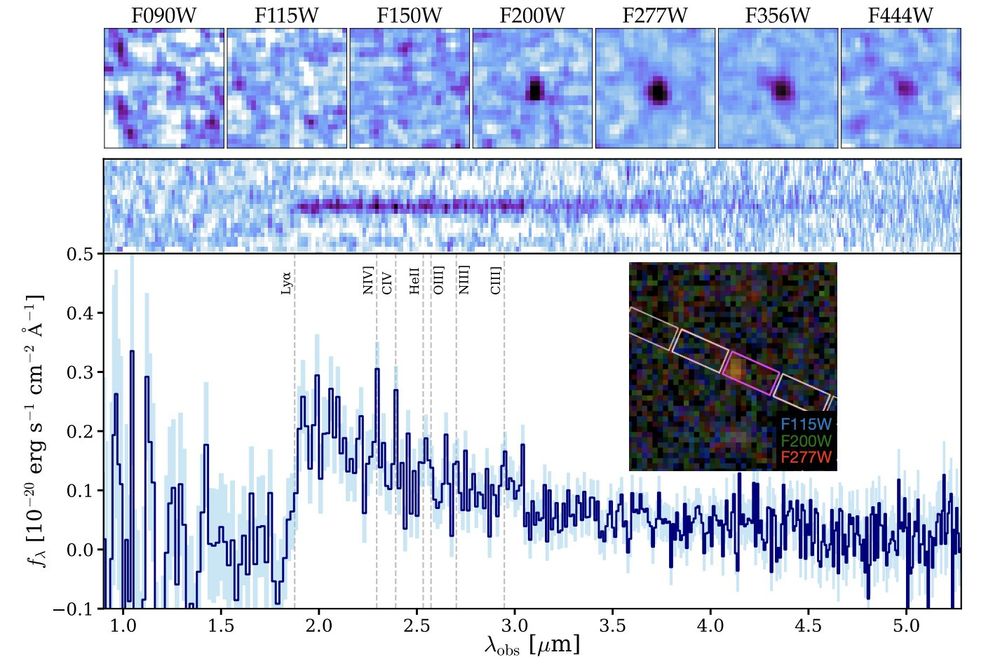
We found the most distant confirmed galaxy
(some Sergej Boebka vibes 😅)
arxiv.org/abs/2505.11263
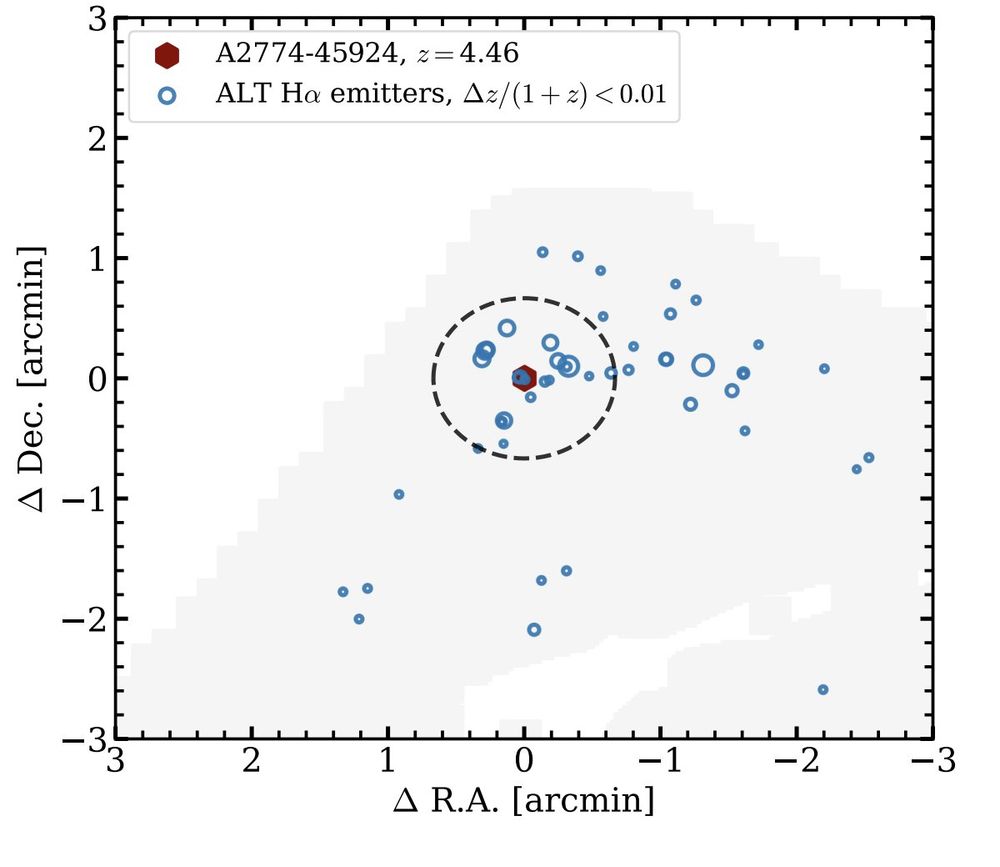
Last week we showed that the environments of typical faint Broad Halpha line emitters -- typically a few neighbours. This monster on the other hand sites in the largest over-density (on ~Mpc scales) in the entire field, supporting the massive galaxy *and* AGN interpretation
09.12.2024 18:33 — 👍 1 🔁 0 💬 0 📌 0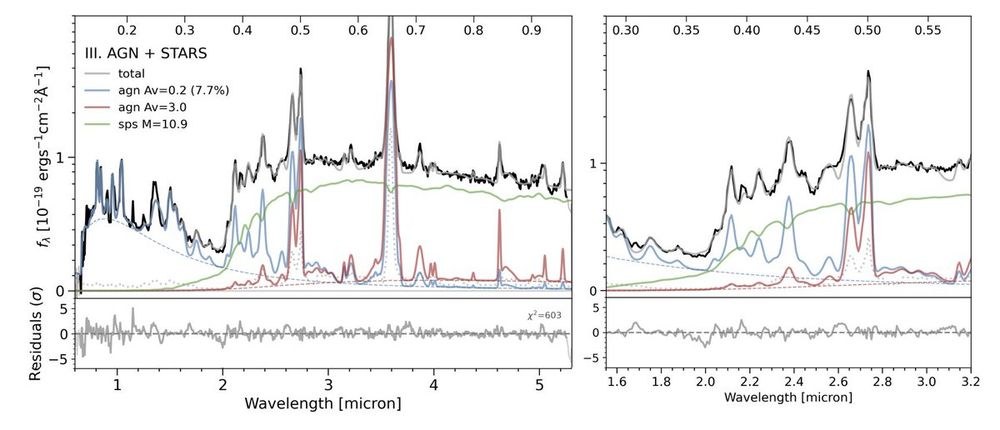
The high quality spectrum really enables detailed fitting of the stellar + AGN component of the galaxy, but higher resolution data would still help.
09.12.2024 18:33 — 👍 1 🔁 0 💬 1 📌 0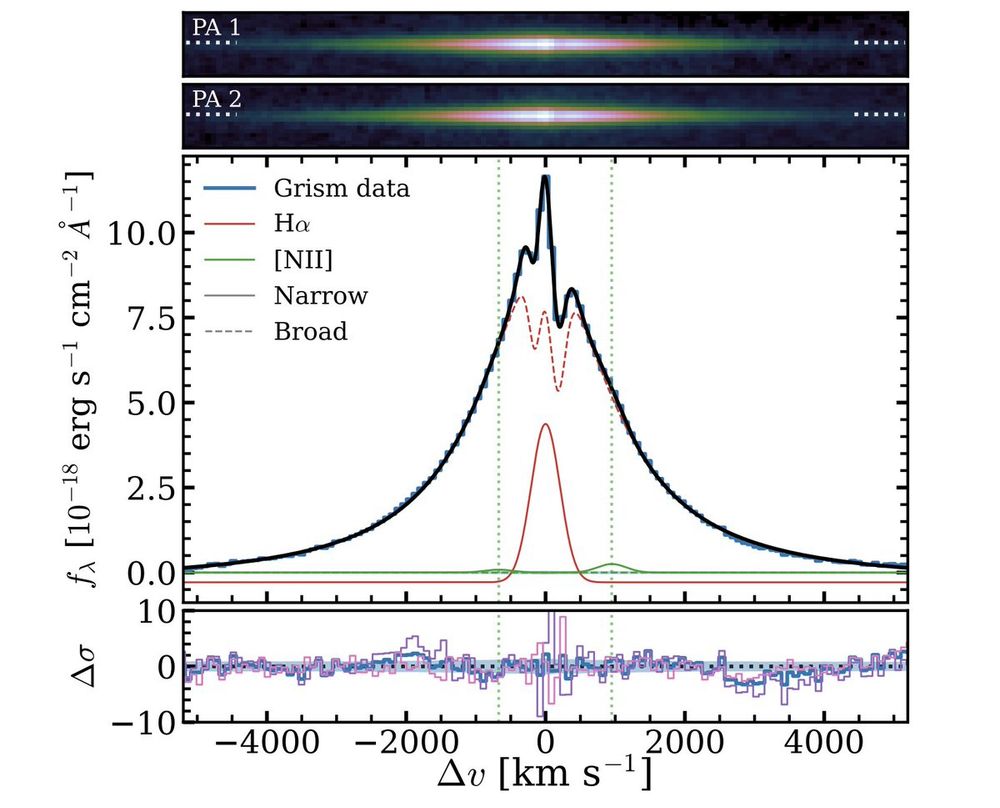
The ALT grism spectrum shows this very nice R~1600 Halpha spectrum with absorption.
09.12.2024 18:33 — 👍 1 🔁 0 💬 1 📌 0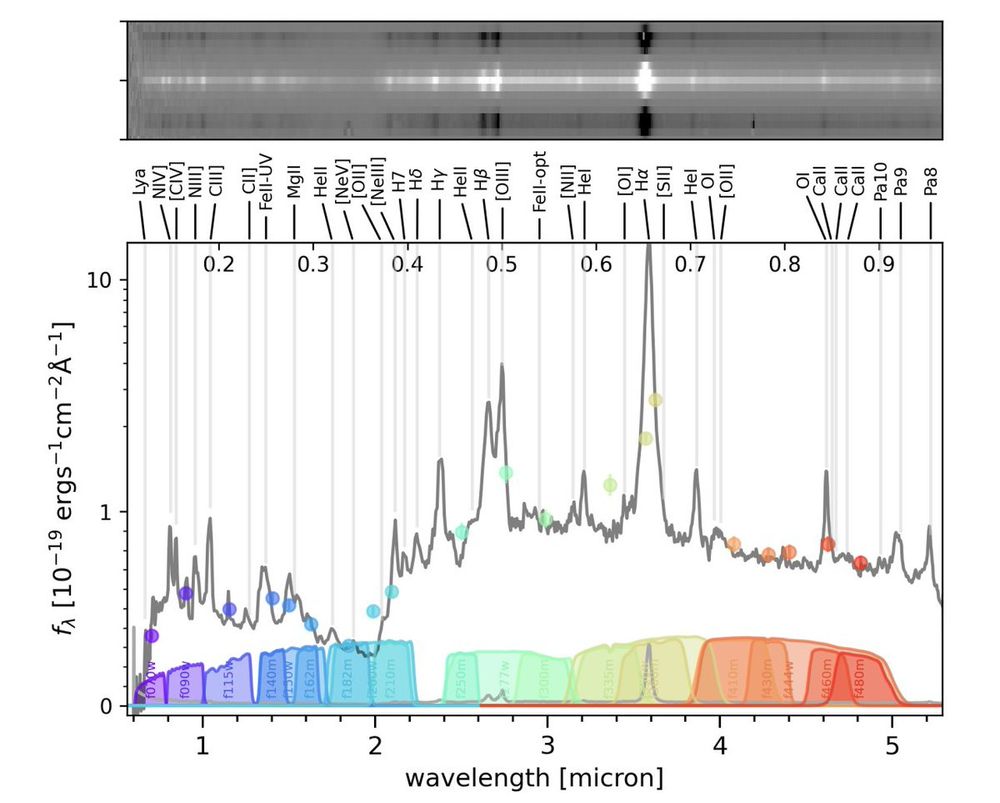
These data speak for themselves, but note in particular the strong UV lines (including nitrogen), the Balmer break and the dominant & broad Balmer lines
09.12.2024 18:33 — 👍 1 🔁 0 💬 1 📌 0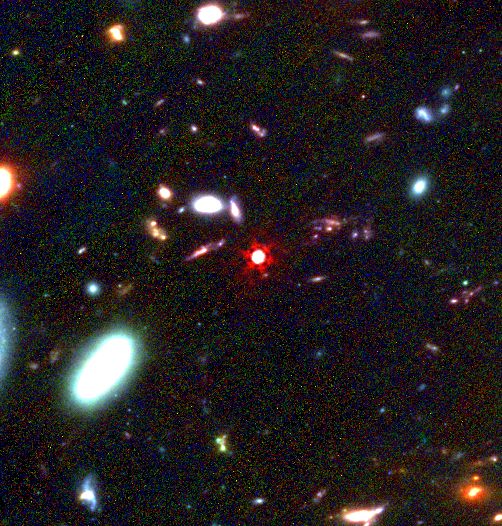
More exciting measurements on the most luminous little red dot that I know of (F444W=22 at z=4.5!): an unambiguous AGN and a Balmer break in deep UNCOVER and ALT spectroscopy, led by Ivo Labbe
arxiv.org/abs/2412.04557
This work was done with the ALT project I have been co-leading with
@rpnaidu.bsky.social, with great contributions from my team members Gauri, Ivan, Claudia and (soon) Alberto at ISTA and collaborators abroad
What's next? First, tests of the BH mass measurements are highly warranted, for example by reobserving these AGNs again over various cadences in the next months/years. Second, we could solidify a BH - halo mass relation quantitatively with larger samples with uniform measurements
06.12.2024 14:33 — 👍 2 🔁 0 💬 1 📌 0Our results are at odds with scenarios where the full broad Halpha line originates from gas dynamics in compact, pure stellar galaxies without AGN, though we do not rule out that this could be one of the processes that may make the BHs appear more massive
06.12.2024 14:33 — 👍 2 🔁 0 💬 1 📌 0These trends indicate a BH to halo mass relation, which implies that more luminous AGNs (that typically have broader line-widths and higher masses) reside in higher mass galaxies, which will have different spectral energy distributions and large-scale environments
06.12.2024 14:33 — 👍 3 🔁 0 💬 1 📌 0